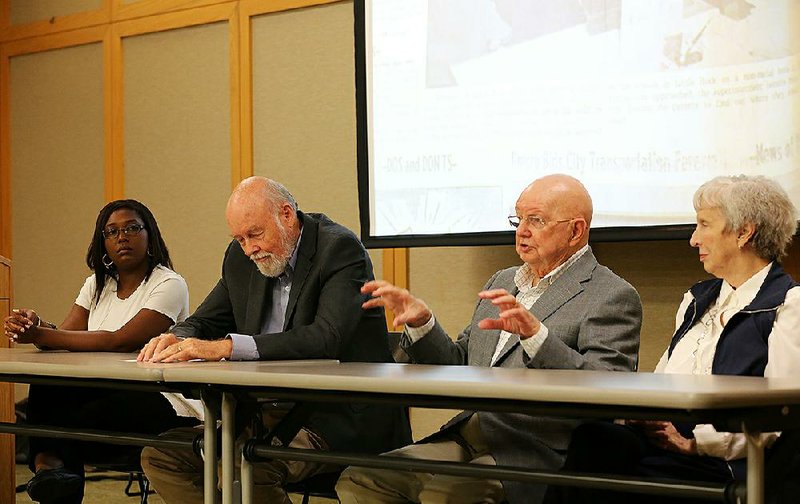Media coverage of Central High School's integration nearly 60 years ago created fear among black families and a resulting lack of detail for students today to connect with, the parent of a graduate and an alumna said Wednesday during a discussion of the crisis.
Edith Moore, a toddler in 1957, said her parents feared integration after reading newspapers chronicling the Central High scene. Moore attended an all-black elementary school before she enrolled in Pulaski Heights Middle School 12 years after Central High's integration.
"My parents were terrified for me to have to go to an integrated school because of what they read in the newspaper," Moore said. "If you see in the news where somebody is spitting on a black child, you really don't want your child to be spit on."
A five-person panel that included three journalists who worked during the Central High Crisis critiqued media coverage of the school's integration. The journalists were Phyllis Brandon who worked for the Arkansas Democrat, Bill Lewis who worked for the Arkansas Gazette and Ernie Dumas who was the co-editor of a college newspaper at the time and later wrote for the Gazette.
Close to 100 people attended the discussion in the Darragh Center Auditorium at the Central Arkansas Library System's main branch.
Organized by the Society of Professional Journalists Arkansas Pro Chapter, the panel also included Tafi Mukunyadzi, a Central High graduate and former Associated Press reporter, and John Kirk, director of the University of Arkansas at Little Rock Institute on Race and Ethnicity.
A series of public events will commemorate the 60th anniversary of Central High's integration, culminating Sept. 25 at Central High School with remarks by former President Bill Clinton. All eight surviving members of the Little Rock Nine will attend, Little Rock spokesman Lamor Williams said.
More than three years after the U.S. Supreme Court struck down public school segregation in 1954 in its Brown v. Board of Education of Topeka decision, then-Arkansas Gov. Orval Faubus deployed the Arkansas National Guard to stop the nine black teenagers from entering Central High.
Federal troops, on the order of President Dwight Eisenhower, escorted the students into Central High for their first full school day on Sept. 25, 1957.
Moore inherited her parents' fear of integration and Central High, she said, and avoided the school for decades, until 1998 when she went there to enroll her son, who wanted to attend classes there.
"It was traumatic for me to climb those steps," said Moore, who later served as the president of the school's Parent Teacher Association. "My parents hated Central High."
While local media coverage had a lasting impact on her family, what the media didn't cover has left a gap in current students' understanding of the crisis, said Mukunyadzi, a 2008 graduate and the panel's only black member.
Mukunyadzi said the lack of nonwhite voices in statewide newspaper stories from that time -- and the lack of reported details about the nine students' time at Central High -- have made it difficult for the current generation to fully grasp the nine students' experiences.
"It's forcing students who are studying that history and trying to really relate to those students and what they went through -- it's forcing them to look at it in a really different way," such as seeking secondhand accounts from relatives, Mukunyadzi said.
Dumas, who worked at the Arkansas Gazette for 31 years beginning in 1960, said "very little" coverage by Arkansas' daily newspapers included voices from minority-group communities. At the time of the Central High Crisis, Dumas was co-editor of the campus newspaper at Henderson State Teachers College.
"There is virtually no reference to the kids in the school," Dumas said of the Little Rock Nine. "You can see their names, but that's about it. The only paper that did it -- the African-American press, nationally and locally, did a great job of that."
Lewis, a native Mississippian who reported on the crisis for the Gazette, pushed back in what was one of the few points of disagreement Wednesday among the journalists.
"I thought the Gazette -- I don't want to say went overboard at times -- but the sympathy was there," Lewis said.
Among Lewis' stories during the crisis was a front-page article that -- based on the reporter's several calls to pawnshops and gun shops -- contradicted Faubus' statement that he mobilized the National Guard in response to a surge in weapon sales. Lewis also covered community events by pro-integration and pro-segregation groups.
The Gazette received two Pulitzer Prizes for its coverage of the Central High Crisis. The newspaper received an award for public service, and Executive Editor Harry Ashmore received an award for distinguished editorial writing.
Metro on 09/14/2017
